
How to ensure drivers see you when you are cycling
How to ensure drivers see you when you are cycling
Kickstarter, GoFundMe and similar crowdfunding websites are awash with gadgets designed to make cyclists more visible.
From the LED-encrusted Holloway gilet by Lumo, as featured on the Apprentice, to the new Visijax jacket plus numerous other gizmos all designed with cyclists’ safety in mind, not to mention the ‘Cyclists Stay Back’ stickers that adorn nearly every bus and lorry these days, the onus is normally put on cyclists to avoid being hit by other road users, rather than educating drivers to look out for them.
While good lights are a must – and are, of course, a legal obligation – and some may go for reflective clothing, there’s more cyclists can do to avoid collisions.
Indeed, relying on drivers to see you, even if you’re lit up like the proverbial Christmas tree, may lure you into a false sense of security. The reality is, although you may feel safe attired in your day-glo fluorescent yellow cycling jacket and matching trousers, with accompanying hi-spec lights, unfortunately some drivers still may not see you.
Remember that awareness test showing people playing basketball and the moonwalking bear? How many people spotted the bear?
Is pavement riding the answer?
So, what’s the solution? Ride on the pavement or footway? Surely that’s safer? No, it’s illegal for a start, unless the path is designated shared use.
It may also be more unwise than you realise. Think about all the hazards that you might encounter: street furniture, dropped kerbs, unlit defects, pedestrians, vehicles emerging from driveways and many more. And yes, many so-called cycle tracks include many of these!
No, the best thing you can do, day or night, is to think about your road positioning and how you interact with other road users – if you interact with them at all, that is. Let’s take a look at some common situations and how you can help protect yourself from the ‘Sorry, mate, I didn’t see you’ scenario.
Passing a side road
Junctions are one of the most common places where drivers may not see you. For a start, they may not be looking for cyclists; secondly, you may be in their ‘blind spot’', and third, they may see you but misjudge how fast you’re going, or may see you but not register your presence.
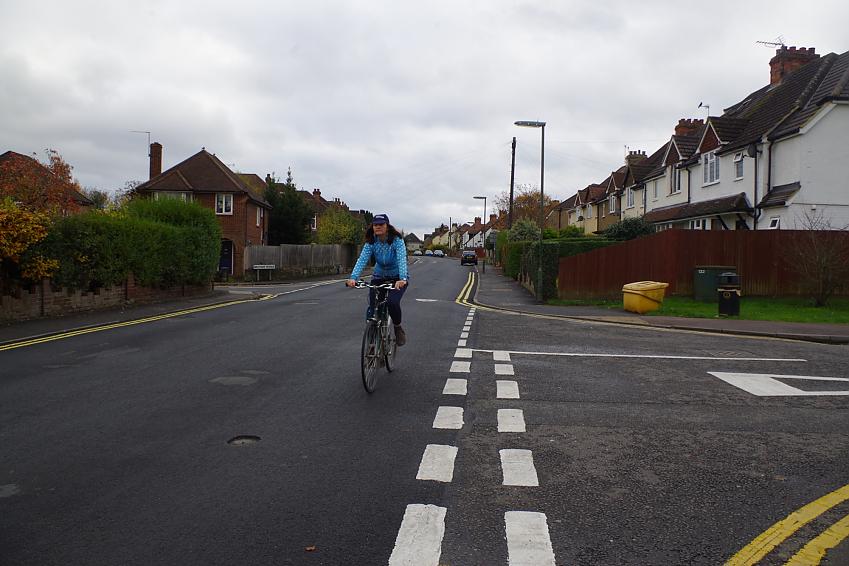
Long before you reach a turning on the left-hand side of the road, check carefully behind and see if it’s clear. This may not always be so easy on a fast main road, but if you start the manoeuvre in plenty of time, indicating if necessary to get into the flow of vehicles, it can be very effective.
If it’s safe to do so, move further out into the centre of the lane so that if a vehicle is emerging from the side road, you are not in the blind spot. This will make you more visible and also mean there’s more space between you and the front of the vehicle so, if the driver does still pull out, you have a bit more time to take evasive action.
You can also try to make eye contact – if I’m not 100% sure a driver has seen me, I will slow down or even stop rather than risk it. Keeping your fingers on your brake levers will mean you’re ready for this at all times and could buy a few vital seconds.
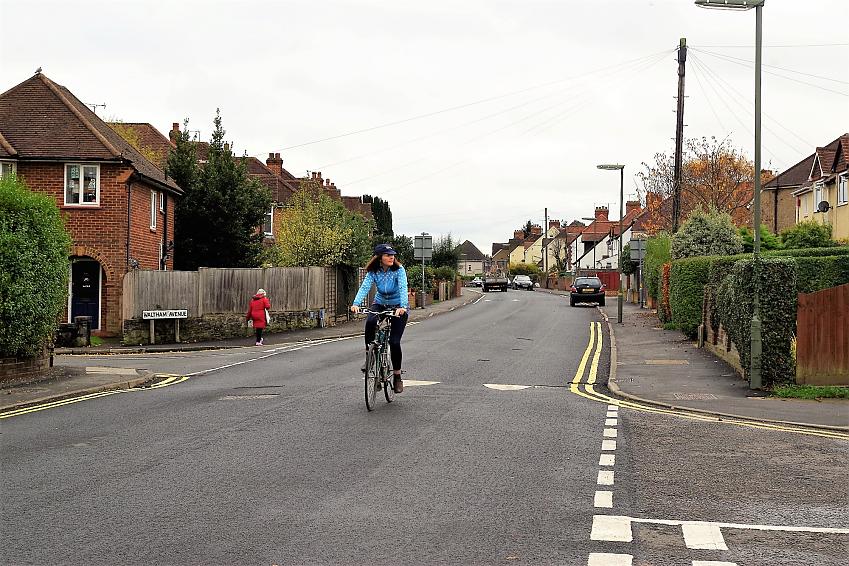
Don’t worry about vehicles coming up from behind – if they have let you in, they have seen you; if not, and they have appeared after your manoeuvre, they are still much more likely to see you than somebody emerging from a junction. Their inconvenience is a small price to pay for your safety.
But even if they seem impatient, don’t be put off. You are helping the traffic flow more smoothly and also, by making yourself more visible, helping drivers to drive more confidently around you.
Don't forget to check down side roads, driveways and junctions on the other side of the road too.
Passing a parked vehicle
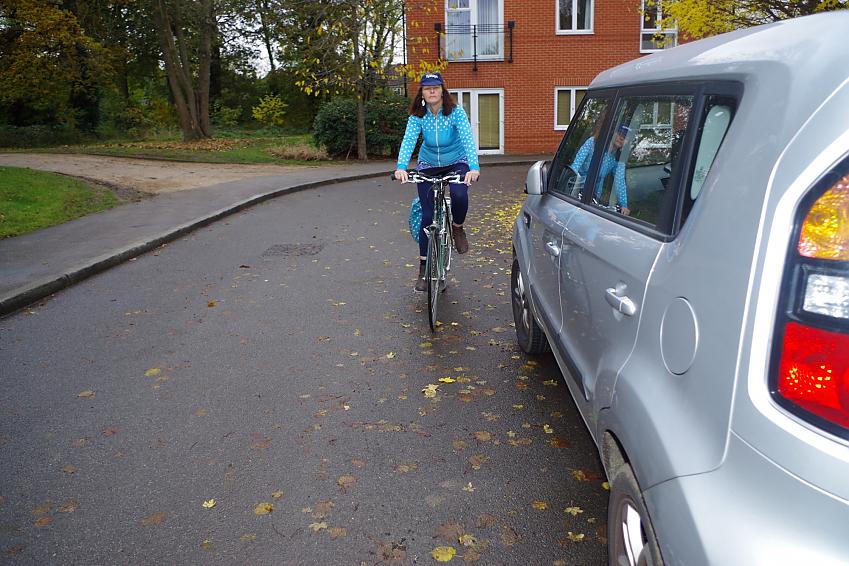
Similarly, when you ride past a parked car you may be invisible to anyone in it who isn’t looking properly. It’s quite hard to see a cyclist coming up beside you if you’re in a parked vehicle.
Don’t rely on being seen. Make sure you’re riding at least a car door’s width away from any vehicles. They may suddenly pull away or even open a door into your path. Watch our Dutch Reach video to see how drivers are taught to open car doors in the Netherlands so that they are less likely to ‘door’ cyclists riding past.
Keep as far away from stationary vehicles as possible (although there may be times when it’s unavoidable, unfortunately). Again, not only will it be easier to see you but you will also be able to interact more easily with drivers in front of and behind you, meaning they will be more likely to give you room.
Look behind regularly to keep an eye on what’s going on and signal your intentions clearly if it’s safe to do so.
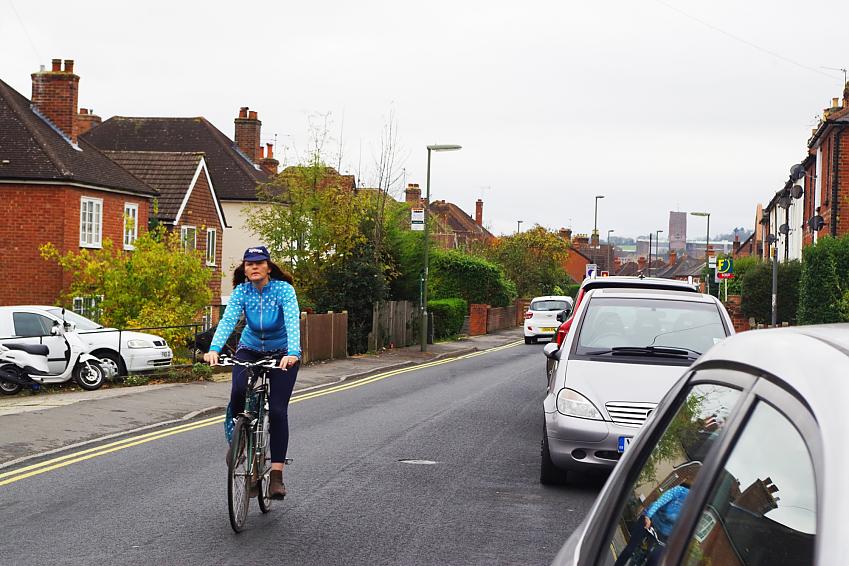
Passing slower moving vehicles
You’re riding along enjoying the freedom of the open road when the traffic slows down and you’re stuck behind a row of vehicles at a set of traffic lights or approaching a roundabout. It’s very likely you’ll spot a gap on the inside of the queue and aim for it, especially if there’s a cycle lane marked. But is that where you’ll be most visible?
Drivers may not be expecting anything to pass them on the inside, and passengers may be tempted to hop out without looking behind. It’s better to overtake on the outside of the queue, again leaving as much room as possible, and wait either behind the first car or, if there’s enough space, at the front of the queue.
However, if the first vehicle in the queue is a lorry or HGV, make sure you can make eye contact with the driver as they may not be able to see you just in front of them.
Top tips
- Don’t rely on being seen by drivers, no matter how brightly you’re dressed
- Be proactive – change road position, interact with other road users, ride assertively
- Make eye contact where possible or at least try and gauge whether or not you’ve been seen
- Cover your brakes so you can slow down or stop when approaching junctions or on roundabouts if you are not sure you’ve been seen
- Move out early and create as much space as possible so you can see and be seen
Nothing can replace getting some National Standard cycle training if you want help putting these tips into practice – an hour or two with an instructor can make all the difference and teach you how to negotiate many different kinds of situations. Some local authorities offer this for free, while others may charge a small amount.






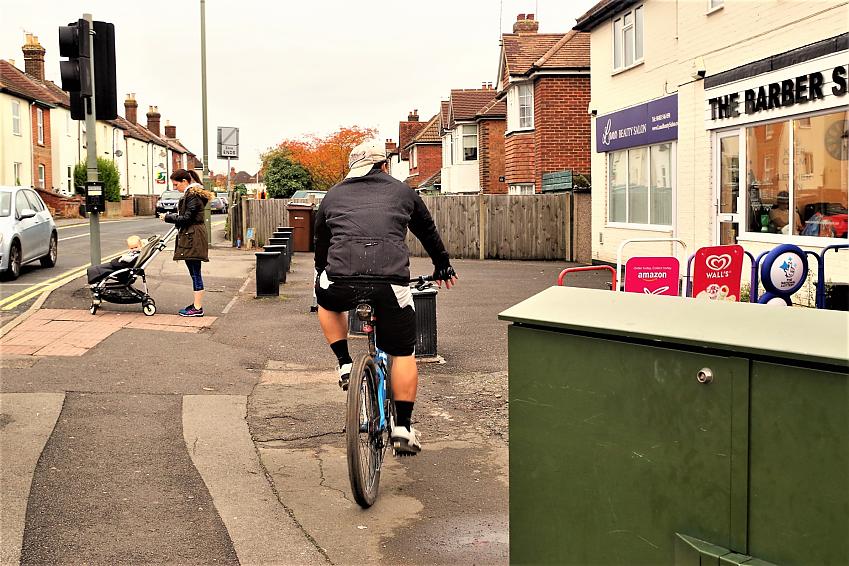
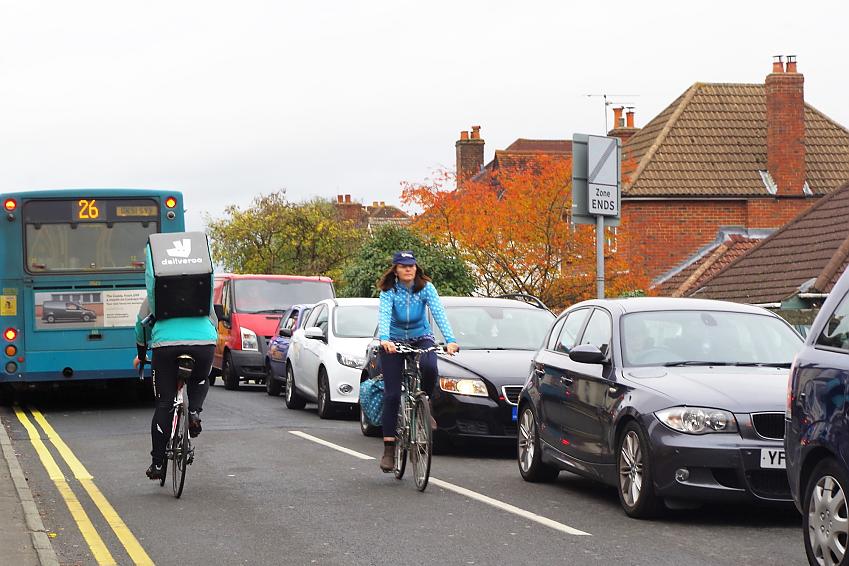
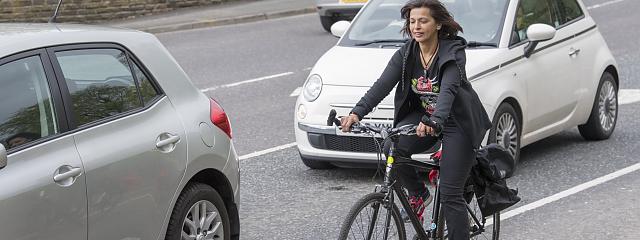
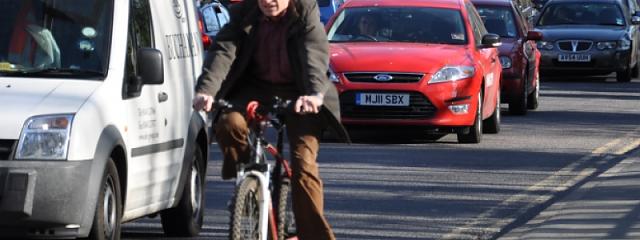
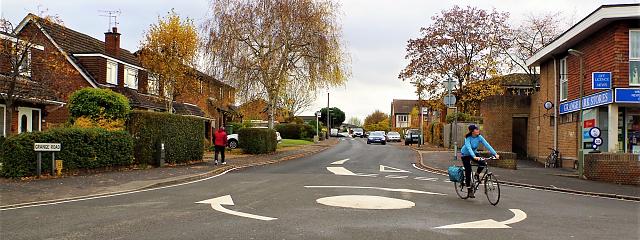
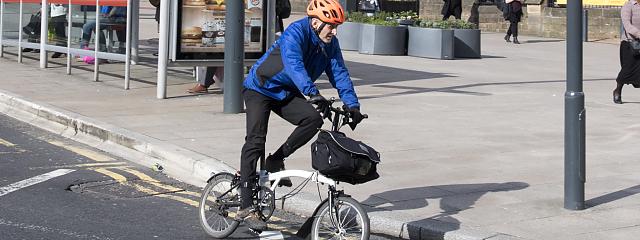
Comments
How to help drivers see you when you are cycling
All of this is sensible advice but LOOKING behind means taking one's eyes too long off what is about to happen in front, eg the vehicle which is about exit from a side road.
Much more sensible to fit a bar-end rear view mirror (eg the vibration-free Myriccle), keep facing forward while glancing in it to see what is coming up behind, and only turn the head very briefly to the side to make sure there is nothing in the blind spot alongside the back wheel before moving out.
Most cyclists' vision is wide enough to keep an eye on the road behind while looking straight ahead.
Looking behind briefly is
Looking behind briefly is perfectly ok and usually gives a wider view. It also is a two way communication - not only does the rider get information from behind, any road user behind gets a clue that the rider is about to do something so they may need to slow or similar whilst the rider carries out their manoeuvre. Also you refer to 'a' mirror, presumably on one side. It is necessary at various times to look over either shoulder. Generally, if you are moving your bike out right then right shoulder, back left then left shoulder.
Mirrors
Mirrors may be useful for some people, particularly those that have trouble with balance or turning their heads around, but are no substitute for having a really good look behind you - this means you can make eye contact with a driver and they will be more likely to see you as real flesh and blood rather than just a nuisance in their way. This is why mirrors and other such gadgets are not recommended as essential equipment under the National Standard in cycle training. And in common with car/van/HGV mirrors, there may also be blind spots which mean you are not necessarily seeing the whole picture.
Looking behind
It's illegal to drive without a clear rear view and plain daft and dangerous to cycle without a mirror to let you know what's going on behind.
You need to know if vehicles are moving out to pass you safely, especially on the open road.
You need to know if it's safe to move from secondary to primary position, especially at 'pinch points'
On country roads always check your mirror when a vehicle is approaching from the front; that's when you need to know if there's any risk of a vehicle attempting to 'squeeze through' from behind.
'Mirror, Signal, Manoeuvre' applies as much when I cycle as when I drive.
On my Brompton the Zefal dooback folding mirror doesn't affect the fold and it has saved my life on at least one occasion.
Looking behind and mirrors
See my comment on mirrors below. Under National Standard training, you should also look behind when moving to the left - this time over the left shoulder to see what might be coming up on the inside. This is called a 'life saver' check. We will cover turning into junctions in a future article.
Modern car design and blind spots
Modern car design has emphasized car occupant safety and fuel efficiency, which may be laudable; but modern vehicles have very big blind spots, on both sides forwards, caused by the thickness and angles of the A-Pillars.
The A-Pillar is the car frame between the windscreen and the side windows and it supports the roof. Over the years it has increased greatly in effective thickness (taking account of the increasing windscreen angle) for increased roof roll-over strength requirements and to incorporate air-bags etc..
A cyclist could easily be hidden from the driver by these very thick pillars, especially if he/she only takes a quick glance.
But! To be fair to drivers; How much time does a driver have to search? Not Long! If he/she does, What happens on today's busy roads? Spend too long looking one way: things change somewhere else! Beware!!
If you do not believe this look at the difference between modern vehicles and those of the 50s, 60s or 70s.
Some elements of modern vehicle design while increasing safety in some respects have been detrimental in others.
Also, by personal experience, I was recently a rear seat passenger on the offside and while stopped, and wishing to emerge, I had to ask the driver if it was safe to open the door.
From the sear, I just could not see if there was any traffic approaching and it was safe.
Correction to first post (ikonta): How to help drivers see you .
The last sentence of my post should include "via the mirror".
"Most cyclists' vision is wide enough to keep an eye via the mirror on the road behind while looking straight ahead."
By this means the traffic coming up behind and the traffic about to emerge from side roads or oncoming traffic about to cross one's path can be kept in view.
I do agree however that turning the head gives an extra signal to (vigilant, wide-awake) drivers that the cyclist is about to manoeuvre, but with a mirror in place that needs to be done only to check the blind spot immediately behind and to the right (if that is the direction of deviation) and can be very brief so that forward vision is hardly interrupted at all.
Correction to first post (ikonta): How to help drivers see you .
The last sentence of my post should include "via the mirror".
"Most cyclists' vision is wide enough to keep an eye via the mirror on the road behind while looking straight ahead."
By this means the traffic coming up behind and the traffic about to emerge from side roads or oncoming traffic about to cross one's path can be kept in view.
I do agree however that turning the head gives an extra signal to (vigilant, wide-awake) drivers that the cyclist is about to manoeuvre, but with a mirror in place that needs to be done only to check the blind spot immediately behind and to the right (if that is the direction of deviation) and can be very brief so that forward vision is hardly interrupted at all.
Looking behind
It all depends on who you are. Many of us older cyclists can no longer turn round to look without wobbling. Nor can we make eye contact with drivers.
I rely on a mirror to see behind me.
Don't think I would dare to ride up the outside of a line of traffic - don't want to be in the middle of the road when the cars suddenly start moving.
Overtake - don't undertake
Perhaps the clue is in the term "undertake" but I am glad to see this advice regarding the overtaking of stopped traffic on the right.
I know many are afraid of this manoeuvre and prefer to undertake, and in some situations that's fine. However, in my opinion it is often safer to overtake stopped cars. Yes, you must be mindful of oncoming traffic, but you that does tend to focus the rider (I see many cyclists undertaking without awareness of the situation) and also places you closer (and in better view of) drivers.
Eye Contact
While I agree that making eye-contact with drivers is a very good idea (and something I always seek to do), it is often much easier said than done. Windscreens have progressively become more sloped (i.e. away from the vertical) and so reflect huge amounts of sky often making it difficult to see into a vehicle and certainly near impossible to make eye contact. I have noticed this both as a driver and a cyclist.
I had an instance this year (when cycling) where I could have passed in front of a moving car but all I could make out was that the driver was gesturing in some way. I stopped, the driver slowed down and I waved him through. Then, through the side window I saw the driver raise his hand in frustration as if to say, "I let you go first but you turned me down and I have had to slow down unnecessarily when you could have gone across - cyclists!".
Another feature which makes eye contact difficult is tinted glass, particularly the darker tints and add on films, which afford complete privacy to rear seat passengers. You can't see if the driver is looking over his shoulder. And a tint to the rear window means you can't see if a driver is looking in their rear view mirror. I also think that some windscreens and front door windows are more reflective than others.
Front on, a flash of headlights can often be the only way you can tell if a driver has seen you but of course headlights should only be used as a warning of danger so you have to read all the messages to decide how to interpret this.
Overtaking (or undertaking) slow moving vehicles
Overtaking is not something to be done lightly. You have to rely on motorists remembering "Think Bike" and that they also extend this thought to the non-motorised type. Motorists simply do not expect to be overtaken by bicycles. So as a cyclist you have to up your spatial awareness and be aware of all the potential hazards.
Much the same is true for undertaking but drivers are more accustomed to cyclists being on the nearside so an undertaking cyclist is not in an unexpected position on the road in slow moving traffic. In start-stop traffic, drivers will often move out to give you more room on the inside but it is rare for a driver to move to the left to give more room on the right to allow cyclists to overtake.
Looking behind.
I always find performing shoulder checks pretty useful, easy to perform, and less dangerous than some people seem to suggesting. Admittedly it is a skill to be learnt, but a valuable one. What is really shocking is how articles like this are still necessary, although the education should fall heavier on motorists shoulders.
My experience is that moving
My experience is that moving into the middle of the road at a junction is also important to stop motorists from turning left across your path, particularly where the left turn is designed so that motorists can take the turn at a fast speed. I was knocked off my bike in this way going home from school back in 1959 by a motorist who claimed he hadn't seen me. (He didn't stop but was apprehended later.) On other occasions I have been cut up in this way by motorists who clearly have seen me. The main problem with the advice, however, is that it is difficult to follow if you are going up a hill.